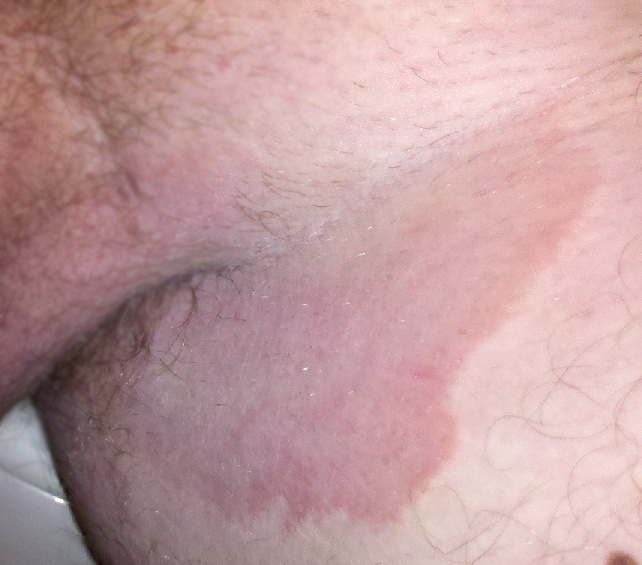Tinea cruris

Editor-In-Chief: Prab R Tumpati, MD
Obesity, Sleep & Internal medicine
Founder, WikiMD Wellnesspedia &
W8MD's medical weight loss NYC, sleep center NYC
Philadelphia medical weight loss and Philadelphia sleep clinics
| Tinea cruris | |
|---|---|

| |
| Synonyms | Jock itch, crotch itch, gym itch |
| Pronounce | N/A |
| Specialty | Dermatology |
| Symptoms | Itching, redness, rash in the groin area |
| Complications | Secondary infection |
| Onset | More common in adolescents and adults |
| Duration | Can be chronic if untreated |
| Types | N/A |
| Causes | Fungal infection by Trichophyton, Epidermophyton |
| Risks | Sweating, tight clothing, obesity, diabetes |
| Diagnosis | Clinical examination, KOH test, fungal culture |
| Differential diagnosis | Intertrigo, psoriasis, contact dermatitis |
| Prevention | Keeping the groin area dry, wearing loose-fitting clothing |
| Treatment | Topical antifungal creams, oral antifungal medications |
| Medication | Clotrimazole, terbinafine, miconazole |
| Prognosis | N/A |
| Frequency | Common |
| Deaths | N/A |
Fungal infection of the groin area
Tinea cruris, commonly known as jock itch, is a dermatophyte fungal infection that affects the groin area. It is a form of tinea, which is a group of diseases caused by fungi known as dermatophytes.
Signs and symptoms[edit]
Tinea cruris typically presents as a red, itchy rash in the groin area. The rash may have a well-defined edge and can spread to the inner thighs and buttocks. The affected skin may become scaly or flaky, and in some cases, blisters may form. The itching can be intense, leading to discomfort and irritation.
Causes[edit]
Tinea cruris is caused by dermatophyte fungi, most commonly Trichophyton rubrum. These fungi thrive in warm, moist environments, making the groin area particularly susceptible. Factors that increase the risk of developing tinea cruris include excessive sweating, wearing tight clothing, and having a weakened immune system.
Diagnosis[edit]
Diagnosis of tinea cruris is typically based on the appearance of the rash and the patient's history. A skin scraping may be taken and examined under a microscope to confirm the presence of fungal elements. In some cases, a culture may be performed to identify the specific type of fungus.
Treatment[edit]
Treatment for tinea cruris involves the use of topical antifungal medications, such as clotrimazole, miconazole, or terbinafine. In more severe cases, oral antifungal medications may be prescribed. It is important to keep the affected area clean and dry, and to avoid tight-fitting clothing to prevent further irritation.
Prevention[edit]
Preventive measures for tinea cruris include maintaining good personal hygiene, keeping the groin area dry, and wearing loose-fitting clothing. It is also advisable to avoid sharing personal items such as towels and to change out of wet clothing promptly after exercising.
See also[edit]
Ad. Transform your life with W8MD's Budget GLP-1 injections from $75


W8MD offers a medical weight loss program to lose weight in Philadelphia. Our physician-supervised medical weight loss provides:
- Weight loss injections in NYC (generic and brand names):
- Zepbound / Mounjaro, Wegovy / Ozempic, Saxenda
- Most insurances accepted or discounted self-pay rates. We will obtain insurance prior authorizations if needed.
- Generic GLP1 weight loss injections from $75 for the starting dose.
- Also offer prescription weight loss medications including Phentermine, Qsymia, Diethylpropion, Contrave etc.
NYC weight loss doctor appointmentsNYC weight loss doctor appointments
Start your NYC weight loss journey today at our NYC medical weight loss and Philadelphia medical weight loss clinics.
- Call 718-946-5500 to lose weight in NYC or for medical weight loss in Philadelphia 215-676-2334.
- Tags:NYC medical weight loss, Philadelphia lose weight Zepbound NYC, Budget GLP1 weight loss injections, Wegovy Philadelphia, Wegovy NYC, Philadelphia medical weight loss, Brookly weight loss and Wegovy NYC
|
WikiMD's Wellness Encyclopedia |
| Let Food Be Thy Medicine Medicine Thy Food - Hippocrates |
Medical Disclaimer: WikiMD is not a substitute for professional medical advice. The information on WikiMD is provided as an information resource only, may be incorrect, outdated or misleading, and is not to be used or relied on for any diagnostic or treatment purposes. Please consult your health care provider before making any healthcare decisions or for guidance about a specific medical condition. WikiMD expressly disclaims responsibility, and shall have no liability, for any damages, loss, injury, or liability whatsoever suffered as a result of your reliance on the information contained in this site. By visiting this site you agree to the foregoing terms and conditions, which may from time to time be changed or supplemented by WikiMD. If you do not agree to the foregoing terms and conditions, you should not enter or use this site. See full disclaimer.
Credits:Most images are courtesy of Wikimedia commons, and templates, categories Wikipedia, licensed under CC BY SA or similar.
Translate this page: - East Asian
中文,
日本,
한국어,
South Asian
हिन्दी,
தமிழ்,
తెలుగు,
Urdu,
ಕನ್ನಡ,
Southeast Asian
Indonesian,
Vietnamese,
Thai,
မြန်မာဘာသာ,
বাংলা
European
español,
Deutsch,
français,
Greek,
português do Brasil,
polski,
română,
русский,
Nederlands,
norsk,
svenska,
suomi,
Italian
Middle Eastern & African
عربى,
Turkish,
Persian,
Hebrew,
Afrikaans,
isiZulu,
Kiswahili,
Other
Bulgarian,
Hungarian,
Czech,
Swedish,
മലയാളം,
मराठी,
ਪੰਜਾਬੀ,
ગુજરાતી,
Portuguese,
Ukrainian